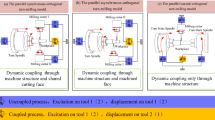Abstract
In orthogonal turn-milling processes, the workpiece and the tool rotate at the same time, which causes the cutting depth and thickness to change instantaneously, whereas the cutting depth is constant in conventional milling. Obviously, the stability model for conventional milling cannot be applied to orthogonal turn-milling. In this paper, a new two-dimensional stability model for orthogonal turn-milling is established in which both variable cutting depth and cross-coupling of the structural mode are considered. The stability lobe diagram is obtained using the full-discretization method. Based on abundant experimental data, we found that the variable cutting depth and cross-coupling of orthogonal turn-milling have an effect on the stability lobe diagram. A theoretical prediction that considers variable cutting depth and cross-coupling increases the stability boundary, and one such prediction is verified by the chatter experimental results.
Similar content being viewed by others
References
Merit HE (1965) Theory of self excited machine tool chatter: contribution to machine tool chatter. J Eng Ind 87:447–454
Marui E, Ema S, Kato S (1983) Chatter vibration of lathe tools—1. General characteristics of chatter vibration. J Eng Ind 105:100–113
Ozdoganlar OB, Endres WJ (1998) An analytical stability solution for the turning process with depth-direction dynamics and corner-radiused tooling. ASME Dyn Syst Control Div Publ DSC 64:511–518
Rao BC, Shin YC (1999) A comprehensive dynamic cutting force model for chatter prediction in turning. Int J Mach Tools Manuf 39:1631–1654
Altintas Y, Budak E (1995) Analytical prediction of stability lobes in milling. CIRP Ann Manuf Technol 44:357–362
Altintas Y (2001) Analytical prediction of three dimensional chatter stability in milling. Int J Ser C 44:717–723
Zatarain M, Munoa J, Peigne G, Insperger T (2006) Analysis of the influence of mill helix angle on chatter stability. CIRP Ann Manuf Technol 55:365–368
Zhang XJ, Xiong CH, Ding Y, Feng MJ, Xiong YL (2012) Milling stability analysis with simultaneously considering the structural mode coupling effect and regenerative effect. Int J Mach Tools Manuf 53:127–140
Merdol SD, Altintas Y (2004) Multi frequency solution of chatter stability for low immersion milling. J Manuf Sci Eng 126:459–466
Insperger T, Stépán G (2002) Semi-discretization method for delayed systems. Int J Numer Methods Eng 55:503–518
Ding Y, Zhu LM, Zhang XJ, Ding H (2010) A full-discretization method for prediction of milling stability. Int J Mach Tools Manuf 50:502–509
Ding Y, Zhu LM, Ding H (2011) Numerical integration method for prediction of milling stability. J Manuf Sci Eng 133:031005
Martins Crichigno Filho J (2012) Prediction of cutting forces in mill turning through process simulation using a five-axis machining center. Int J Adv Manuf Technol 58:71–80
Olvera D, de Lacalle LNL, Compeán FI, Fz-Valdivielso, Lamikiz A, Campa FJ (2012) Analysis of the tool tip radial stiffness of turn-milling centers. Int J Adv Manuf Technol 60:883–891
Pogacnik M, Kopac J (2000) Dynamic stabilization of the turn-milling process by parameter optimization. Proc Inst Mech Eng Part B J Eng Manuf 214:127–135
Zhu L, Wang W, Li H, Yu T (2011) Research on 3D chatter stability of orthogonal and eccentric turn-milling. J Mech Eng 47:186–192
Peng FY, Yan R, Chen W, Yang JZ, Li B (2012) Anisotropic force ellipsoid based multi-axis motion optimization of machine tools. Chin J Mech Eng 25:960–967
Altintas Y (2000) Manufacturing automation: metal cutting mechanics, machine tool vibrations, and CNC design. Cambridge University Press, Cambridge
Author information
Authors and Affiliations
Corresponding author
Rights and permissions
About this article
Cite this article
Yan, R., Tang, X., Peng, F.Y. et al. The effect of variable cutting depth and thickness on milling stability for orthogonal turn-milling. Int J Adv Manuf Technol 82, 765–777 (2016). https://doi.org/10.1007/s00170-015-7418-2
Received:
Accepted:
Published:
Issue Date:
DOI: https://doi.org/10.1007/s00170-015-7418-2




